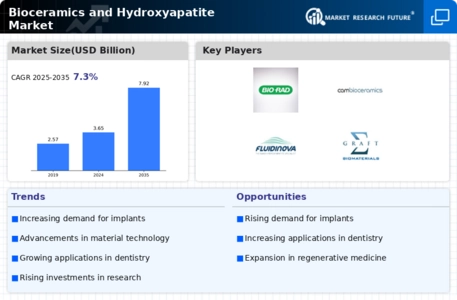Leading market players are investing heavily in research and development in order to expand their product lines, which will help the Bioceramics and hydroxyapatite market, grow even more. Market participants are also undertaking a variety of strategic activities to expand their footprint, with important market developments including new product launches, contractual agreements, mergers and acquisitions, higher investments, and collaboration with other organizations. To expand and survive in a more competitive and rising market climate, Bioceramics and hydroxyapatite industry must offer cost-effective items.
Manufacturing locally to minimize operational costs is one of the key business tactics used by manufacturers in the Bioceramics and hydroxyapatite industry to benefit clients and increase the market sector. In recent years, the Bioceramics and hydroxyapatite industry has offered some of the most significant advantages to medicine. Major players in the Bioceramics and hydroxyapatite market, including GE Healthcare, Bio-Rad, SofSera, ALB Technology Limited, Cam Bioceramics, Bonesupport AB, Fluidinova, Sigma Graft and others, are attempting to increase market demand by investing in research and development operations.
GE HealthCare Technologies Inc. (GE HealthCare) is a leading provider of medical devices, specializing in the design, development, production, and distribution of diagnostic imaging, clinical systems, drug discovery, biopharmaceutical production, cellular technologies, imaging agents for use in medical scanning, and a variety of healthcare IT products. Additionally, GE HealthCare offers services including computerized data management, performance enhancement and performance solutions, and remote diagnosis and repair services for medical devices made by the business and others. The corporation uses subsidiaries and affiliates to run its operations all over the world.
Chicago, Illinois, in the US, serves as the headquarters of GE HealthCare.
Injectable bioceramic bone graft substitutes are developed, manufactured, and sold by BoneSupport AB (BoneSupport), a division of Bonesupport Holding AB, to treat fragility fractures brought on by osteoporosis as well as bone voids and gaps caused by trauma, illness, or surgical procedures. The company manufactures its bone graft substitutes using its patented technical platform CERAMENT. Among its key products are synthetic bone substitutes that release vancomycin and bone void fillers. Additionally, BoneSupport evaluates a variety of prospective pre-clinical product candidates for supporting bone development. The company uses a network of distributors to market its products in North America and Europe.
BoneSupport's corporate headquarters are in Lund, Sweden.















